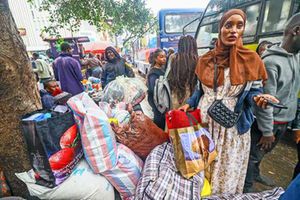Draft is out, read it yourself

The proposed constitution, whose copy is displayed by Anglican Bishop Mwai Abiero of the Maseno South Diocese, is now in the public domain after it was officially released by AG Amos Wako on Thursday. Photo/FILE
What you need to know:
- DRAFT CONSTITUTION: The Government Printer has made 6 million copies which wananchi will have time to study before the referendum that must take place by August 6
The proposed constitution is finally in the public domain. The document should help readers make up their minds about the contents of the draft.
The campaign before the referendum when voters will decide whether to accept or reject the biggest overhaul of the nation’s laws since independence, has been marked by misinformation by both sides.
The draft published in this edition answers many of the questions that have dominated debate.
One of the most emotive questions raised in recent weeks on abortion is answered on page seven of the pullout, in Article 26 (4). The section outlines the proposals on abortion and the circumstances under which the procedure can be carried out.
The Bill of Rights in the first segment of the pullout enumerates the rights that will be conferred on citizens in a section that has been described as one of the most elaborate in any constitution on the continent outside South Africa.
On page six, in Article 24 (5), limitations on the rights conferred in the Bill of Rights are addressed. This should answer the question whether the draft allows members of the military and police force to strike.
Some opponents of the draft have argued that the proposed law would see the government empowered to take away people’s property and land. They have urged voters to reject the draft on these grounds. Whether this is the right position is outlined on page eight in Article 40 which deals with the individual’s right to property.
The land issue has triggered the most heated debate in regions such as Rift Valley province. What the draft actually says is spelt out in great detail in Chapter Five, which is found on pages 11 and 12. This section outlines the circumstances under which non-citizens can own land and the length of leasehold tenure.
It prescribes the circumstances under which the state may regulate land use and spells out the duties of the National Land Commission.
In Articles 63 and 64, the draft defines community and private land, provisions that will tackle the assertions spread by some politicians that community land will no longer be recognised under the law.
For civil servants, Chapter Six on page 13 prescribes what is expected of public officials if voters approve the law.
It states the criteria for employment in public service, including selection on the basis of personal integrity, competence and suitability.
The section also states the rules on acceptance of gifts or donations by civil servants in Article 76 and forbids them from holding bank accounts outside the country unless permitted by an Act of Parliament.
According to Article 77 (1), public servants will not be allowed to participate in business while in government employment.
Does the proposed constitution create an imperial presidency? This is answered onm page 20 in Chapter Nine which addresses the duties and responsibilities of the President. It also outlines the process of vetting which of his appointees will go through in the House.
In the transitional clauses at the end of the pullout, the draft states the procedure for appointment of officials picked before 2012, which will require full consultation between the President and Prime Minister.
In addition, Chapter Nine, to be found on page 20, reviews the procedure for election of a president and states the process of determining when he will be sworn in, a clause presumably designed to avoid a situation like the one witnessed after the last General Election.
One of the most fundamental changes introduced by the proposed law is the introduction of a system of devolution which will see counties created to serve as the channels through which resources will be channelled at the local level.




